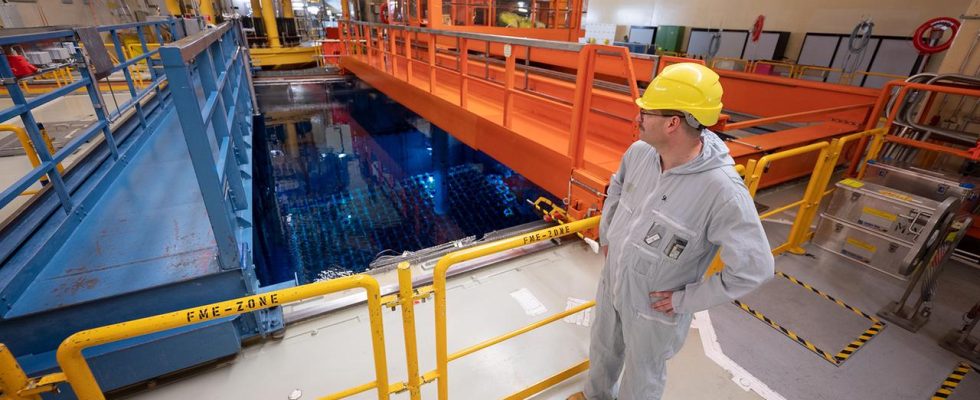Energy was generated from nuclear power in Neckarwestheim for almost 50 years. The kiln has been standing still since mid-April and dismantling is now beginning. The operator gives a clear rejection of a renewed activation.
At first glance, everything in Neckarwestheim near Heilbronn seems as usual. The Neckar flows along vineyards through the Neckar loop and, as it has done for decades, passes the Neckarwestheim nuclear power plant. Cooling tower and reactor building, gray industrial halls – a familiar sight for the residents of Neckarwestheim and neighboring Kirchheim.
The reactor in Block II has been idle since April 16, after electricity production in Block I stopped in 2011. A look at the display on the company premises reveals that something has changed, which shows the current output of Block II as zero megawatts. The nuclear power plant is shut down and nuclear power in Germany is history.
665 fuel rods must cool down
Jörg Michels, head of the nuclear power division of the energy company EnBW, is leading a small group of journalists through the nuclear power plant on this summery afternoon. A rare opportunity, possibly one of the last. “We obtained the decommissioning and dismantling permit for this facility prior to the shutdown, and last week we exercised that permit,” said Michels.
In the reactor building, where electricity was still being produced for millions of households in Baden-Württemberg up until a little over a month ago, you can only go with protective equipment: green overalls, yellow helmet, and white shoes with overcoats up to the knees.
Fuel element storage boxes can be seen in the cooling pond of the reactor building of Unit II.
“Behind us is the fuel pool,” says Michels, pointing to a dark blue pool of water that resembles a swimming pool. “That’s where the fuel elements are stored. Also those that were responsible for the operation in the reactor pressure vessel until the very end,” says the head of the nuclear power division. A total of 665 fuel rods decay at the foot of the basin. The process takes three to four years, only then can the old fuel elements be packed and stored in Castor casks.
Mining around the fuel rods is expected to start in a few weeks. “Primary circuit decontamination” is what Michels calls what is to begin in late summer. According to the Association of German Engineers, the elements of the so-called primary circuit are “flushed out with acid” to the dpa news agency. The aim is to reduce radiation exposure.
energy for millions
With Block II, a real heavyweight has gone off the grid in Neckarwestheim. According to the company, it has produced more than 375 billion kilowatt hours of electricity in its 34 years of operation. In 2021, nuclear energy still accounted for 22 percent of gross electricity generation in Baden-Württemberg. Nationwide it was around 12 percent in the same period.
The EnBW Kernkraft Managing Director does not want to comment on the fact that nuclear power is experiencing a kind of renaissance elsewhere. “In Germany, the issue of nuclear energy has been resolved,” says Michels. It is now important to push ahead with the expansion of the power grid and renewable energies. To date, electricity from biomass, photovoltaics and wind power has made up around 36 percent of the energy mix in Baden-Württemberg. Above all, the wind power share of around five percent is considered to be in need of improvement.
Demolition as a mammoth task
A detour to Block I in Neckarwestheim, which was shut down in 2011, shows that dismantling and dismantling is a mammoth task. There are now gaping holes in the ground where huge steam turbines used to generate electricity. The machine hall is as good as empty. The dismantling is progressing, but it will take years before the buildings can be demolished. And Block II is following suit. “With the start of the dismantling of GKN II, we are assuming ten to 15 years of dismantling within the framework of nuclear law and then another three to four years for conventional demolition,” says Managing Director Michels.
View of the hybrid cooling tower of Block II of the Neckarwestheim nuclear power plant. For reasons of landscape protection, it was only built a good 50 meters high.
Michels does not see a way back. The “point of no return” has been reached, so the shutdown is irreversible. Ideas from the Union or the FDP, which call for a nuclear power plant reserve and a “deconstruction moratorium” in a party congress resolution, “in order to fundamentally enable later continued operation while complying with safety requirements,” he rejects. This is not possible with the expiry of the operating license for legal reasons alone.
According to EnBW, it will cost 9 billion euros to dismantle all reactor blocks. This is now coordinated by the remaining 600 employees – until, in about 15 to 20 years, the nuclear power plant itself will no longer be visible.

